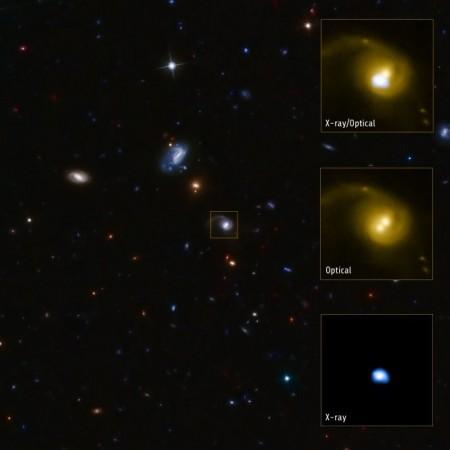
NASA astronomers have found evidence that a giant black hole is getting ejected from its host galaxy at a speed of several million miles per hour.
The astronomers observed on NASA's Chandra X-ray observatory and noticed that the black hole collided and merged with another black hole, thus receiving a recoil kick due to the gravitational wave radiation.
"It's hard to believe that a supermassive black hole weighing millions of times the mass of the sun could be moved at all, let alone kicked out of a galaxy at enormous speed," said Francesca Civano of the Harvard-Smithsonian Center for Astrophysics (CfA), who led the new study.
"But these new data support the idea that gravitational waves - ripples in the fabric of space first predicted by Albert Einstein but never detected directly - can exert an extremely powerful force," she added.
Civano and her colleagues studied a system known as CID -42 in the centre of a galaxy which is 4 billion light years away. Using optical data from the ground-based Magellan and Very Large Telescopes in Chile, they noticed that two sources were moving apart at a speed of 3 million miles/ per hour.
Earlier camera observations from Chandra X-ray observatory, which was not pointed directly towards CID- 42, showed a bright X-ray source caused by a super-heated material around one or more black holes. The scientists weren't able to detect whether it was caused by one or more optical sources, according to NASA.
"The previous data told us that there was something special going on, but we couldn't tell if there were two black holes or just one," said another co-author Martin Elvis, also of CfA.
"We needed new X-ray data to separate the sources," he added.
Later, when the Chandra's high-resolution cameras were pointed at CID-42, the scientists noticed that the bright optical source was caused by one black hole. The other optical source is believed to be a bright star cluster left behind. Civano and her team believe that the optical source is caused because of a collision between two galaxies.
Accordingly, when two galaxies collided with each other, the black holes present in the centre of the two galaxies also collided and merged. The gravitational waves that occur due to the collision emitted in one direction which in turn recoiled the black hole, thus forcing them out of the galaxy.
The scientists also think there are two other possibilities for the black hole to get ejected out of the galaxy. One of them is that there could have been three black holes and when they collided, the lightest could have been ejected. The second possibility is that there should have been two black holes which spiralled towards each other instead of one black hole moving away quickly.
But, both these explanations are only possible if at least one of the black holes was vague (obscure) as the scientists were able to observe only one optical source through the X-ray observatory.
The study has been published in The Astrophysical Journal .













!['It's not Mumbai traffic, it's air traffic': Suriya apologises to Mumbai media after paparazzi yelled At Him for making them wait for hours [Watch]](https://data1.ibtimes.co.in/en/full/806234/its-not-mumbai-traffic-its-air-traffic-suriya-apologises-mumbai-media-after-paparazzi.jpg?w=220&h=138)



